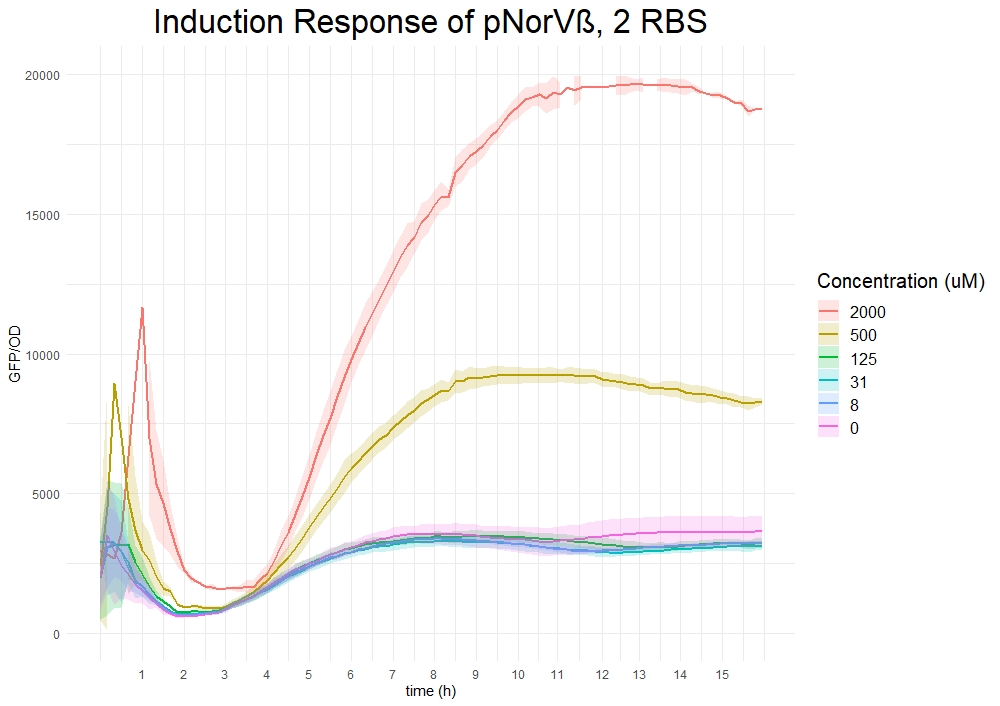Difference between revisions of "Part:BBa K4387006"
| Line 1: | Line 1: | ||
| − | |||
| − | |||
<partinfo>BBa_K4387006 short</partinfo> | <partinfo>BBa_K4387006 short</partinfo> | ||
| − | + | ==Usage and Biology== | |
| − | + | In the frame of our project, we wanted to improve the construct <html><a href="https://parts.igem.org/Part:BBa_K4387005">BBa_K4387005</a></html> by adding one more ribosomal binding site to see if we could achieve a higher GFP response. | |
| − | + | Thus this part consists of the inducible <html><a href="https://parts.igem.org/Part:BBa_K4387000">pNorVβ promoter</a></html>, superfolder GFP preceded by two strong ribosomal binding sites (<html><a href="https://parts.igem.org/Part:BBa_B0029">BBa_B0029</a></html>, <html><a href="https://parts.igem.org/Part:BBa_B0034">BBa_B0034</a></html>), the (<html><a href="https://parts.igem.org/Part:BBa_K4387001">NorR regulator</a></html>), and a <html><a href="https://parts.igem.org/Part:BBa_B0015">double forward terminator</a></html>. We chose a high-copy backbone from Twist Bioscience for this part. Due to the competitive binding of the activated and inactivated NorR on the promoter, we decided on this construct with a positive feedback loop that adjusted the levels of NorR based on the amount of nitric oxide present [1]. The presence of nitric oxide would activate pNorVβ to induce GFP and NorR expression. Thereby, we ensure that high amounts of NorR will be produced only when NO is present. | |
This construct was tested in the bacterial strain E.coli Nissle 1917. | This construct was tested in the bacterial strain E.coli Nissle 1917. | ||
| − | === | + | ==Characterization== |
| − | + | ||
| − | + | ||
| − | + | ||
| + | According to figure__, we could prove that this construct with two ribosomal binding sites and the codon-optimized NorR had the highest GFP response. | ||
| − | = | + | While this part has higher overall GFP expression values, it is also leakier than the constructs with one or three ribosomal binding sites. If high GFP expression is required, but some leakiness does not matter much, we recommend choosing <html><a href="https://parts.igem.org/Part:BBa_K4387006">BBa_K4387006</a></html>. If lower leakiness is essential, but GFP expression does not need to be very high, we recommend using parts <html><a href="https://parts.igem.org/Part:BBa_K4387005">BBa_K4387005</a></html> or <html><a href="https://parts.igem.org/Part:BBa_K4387007">BBa_K4387007</a></html> instead. |
===Measurements=== | ===Measurements=== | ||
| Line 27: | Line 23: | ||
| − | + | ==Sequence and Features== | |
| − | === | + | |
| − | + | ||
<!-- --> | <!-- --> | ||
| + | <span class='h3bb'/span> | ||
| + | <partinfo>BBa_K4387006 SequenceAndFeatures</partinfo> | ||
| − | + | ==References== | |
| + | <ul> | ||
| + | <li>[1] Xiaoyu J. Chen, Baojun Wang, Ian P. Thompson, and Wei E. Huang et al. Rational Design and Characterization of Nitric Oxide Biosensors in E. coli Nissle 1917 and Mini SimCells ACS Synthetic Biology 2021 10 (10), 2566-2578 <html><a href="https://pubs.acs.org/doi/abs/10.1021/acssynbio.1c00223">DOI: 10.1021/acssynbio.1c00223</a></html></li> | ||
| − | + | <li>[2] Ayelet Levin-Karp, Uri Barenholz, Tasneem Bareia, Michal Dayagi, Lior Zelcbuch, Niv Antonovsky, Elad Noor, and Ron Milo et al. Quantifying Translational Coupling in E.coli Synthetic Operons Using RBS Modulation and Fluorescent Reporters ACS Synthetic Biology 2013 2 (6), 327-336 <html><a href="https://pubs.acs.org/doi/10.1021/sb400002n">DOI: 10.1021/sb400002n</a></html></li> | |
| + | </ul> | ||
| + | |||
| + | |||
| + | <!-- Uncomment this to enable Functional Parameter display | ||
| + | ===Functional Parameters=== | ||
| + | <partinfo>BBa_K4387006 parameters</partinfo> | ||
| + | <!-- --> | ||
Revision as of 18:13, 8 October 2022
Nitric Oxide Sensing Genetic Circuit With Two Ribosomal Binding Sites
Contents
Usage and Biology
In the frame of our project, we wanted to improve the construct BBa_K4387005 by adding one more ribosomal binding site to see if we could achieve a higher GFP response.
Thus this part consists of the inducible pNorVβ promoter, superfolder GFP preceded by two strong ribosomal binding sites (BBa_B0029, BBa_B0034), the (NorR regulator), and a double forward terminator. We chose a high-copy backbone from Twist Bioscience for this part. Due to the competitive binding of the activated and inactivated NorR on the promoter, we decided on this construct with a positive feedback loop that adjusted the levels of NorR based on the amount of nitric oxide present [1]. The presence of nitric oxide would activate pNorVβ to induce GFP and NorR expression. Thereby, we ensure that high amounts of NorR will be produced only when NO is present.
This construct was tested in the bacterial strain E.coli Nissle 1917.
Characterization
According to figure__, we could prove that this construct with two ribosomal binding sites and the codon-optimized NorR had the highest GFP response.
While this part has higher overall GFP expression values, it is also leakier than the constructs with one or three ribosomal binding sites. If high GFP expression is required, but some leakiness does not matter much, we recommend choosing BBa_K4387006. If lower leakiness is essential, but GFP expression does not need to be very high, we recommend using parts BBa_K4387005 or BBa_K4387007 instead.
Measurements
Sequence and Features
- 10COMPATIBLE WITH RFC[10]
- 12COMPATIBLE WITH RFC[12]
- 21INCOMPATIBLE WITH RFC[21]Illegal XhoI site found at 726
- 23COMPATIBLE WITH RFC[23]
- 25COMPATIBLE WITH RFC[25]
- 1000COMPATIBLE WITH RFC[1000]
References
- [1] Xiaoyu J. Chen, Baojun Wang, Ian P. Thompson, and Wei E. Huang et al. Rational Design and Characterization of Nitric Oxide Biosensors in E. coli Nissle 1917 and Mini SimCells ACS Synthetic Biology 2021 10 (10), 2566-2578 DOI: 10.1021/acssynbio.1c00223
- [2] Ayelet Levin-Karp, Uri Barenholz, Tasneem Bareia, Michal Dayagi, Lior Zelcbuch, Niv Antonovsky, Elad Noor, and Ron Milo et al. Quantifying Translational Coupling in E.coli Synthetic Operons Using RBS Modulation and Fluorescent Reporters ACS Synthetic Biology 2013 2 (6), 327-336 DOI: 10.1021/sb400002n


